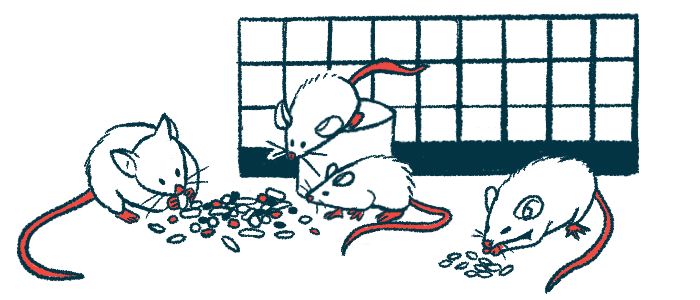FORCE Platform Delivers Exon-skipping Therapy Directly to Muscles
A preclinical mouse study shows potential as treatment for Duchenne MD

Dyne Therapeutics’ FORCE platform delivered its investigational exon-skipping therapy for Duchenne muscular dystrophy (DMD) directly to muscles in a mouse model of the disease, according to the results of a preclinical study.
The potential DMD treatment improved dystrophin protein production and enhanced physical activity in treated mice.
The FORCE platform has the potential to provide an effective treatment for people with DMD, the authors noted.
“[The] publication of our DMD program data in Nucleic Acids Research is a significant recognition of the FORCE platform and highlights the importance of targeted delivery,” Oxana Beskrovnaya, PhD, said in a press release. Beskrovnaya is chief scientific officer of Dyne Therapeutics, the therapy’s developer.
The preclinical study, “Enhanced exon skipping and prolonged dystrophin restoration achieved by TfR1-targeted delivery of antisense oligonucleotide using FORCE conjugation in mdx mice,” was published in the journal Nucleic Acids Research.
Mutations in the DMD gene result in deficient levels of working dystrophin protein, leading to progressive weakness and muscle damage.
Disease-causing mutations can cause missing exons, which are segments within the gene that carry the instructions to make dystrophin. As a result, exon-skipping therapy — designed to mask specific exons — is a treatment approach for people with certain DMD mutations.
DYNE-251 is an exon-skipping therapy by Dyne made from phosphorodiamidate morpholino oligomers (PMOs), which are short, lab-made molecules designed to allow exon 51 to be “skipped,” leading to the production of a smaller but functional version of the dystrophin protein.
Because the efficacy of currently approved therapeutics that use PMO chemistry is limited by poor muscle delivery, there is a need for new methods to deliver exon-skipping PMOs directly to muscles. Dyne developed the FORCE platform to overcome this limitation by connecting the PMO to an antibody fragment that binds to specific receptors on muscle cells.
FDA wanted more information
Earlier this year, the U.S. Food and Drug Administration placed a hold on Dyne’s application to launch a clinical trial evaluating DYNE-251, requesting additional clinical and non-clinical information. The company said it still anticipates patient dosing to begin this year.
Scientists at Dyne now have published details evaluating a FORCE-linked PMO in mdx mice, an established DMD model that carries a mutation in exon 23 of the dystrophin gene. This mouse model provides a useful system to study the effectiveness of exon-skipping therapies.
After confirming that the FORCE-linked PMO, called FORCE–M23D, was internalized into muscle cells, the team tested the impact of M23D, with and without FORCE, in the DMD mouse model.
Administered directly into the bloodstream by tail vein injection, FORCE–M23D led to a dose-dependent distribution of the PMO to the heart and skeletal muscles, significantly higher than with M23D alone.
Dose-dependent exon 23 skipping was detectable three days after FORCE–M23D administration, peaking after one week in all muscles tested. Notably, with a single dose, exon skipping was detectable for eight weeks in heart and abdominal muscles up to 12 weeks in leg muscles. In contrast, only one mouse given M23D alone showed detectable exon skipping, though it was no longer detectable at eight weeks post-dose.
Consistently, a high dose of FORCE–M23D increased dystrophin production to 51% of normal levels in the thigh muscle, 72% in one calf muscle and 62% in another, 90% in the abdominal muscles, and 77% in the heart. The team noted durable dystrophin production for up to eight weeks in the heart and abdomen and up to 12 weeks in the hindlimb muscles.
The presence of dystrophin-positive muscle fibers also increased with treatment, whereas the creatine kinase (CK) levels, which reflect inflammation or damage of muscles, decreased at both two and four weeks post-dose.
‘A strong foundation’
“The magnitude and durability of dystrophin restoration observed in the mdx model, especially in the heart and diaphragm, muscles that are critical in the progression of Duchenne, provide a strong foundation to build our global DMD franchise and a tremendous sense of urgency as we prepare to bring DYNE-251 to patients in the clinic this summer,” said Beskrovnaya.
Finally, in the running wheel test, vehicle-given mdx mice traveled a significantly shorter distance than healthy mice also receiving vehicle. In contrast, the distance traveled by mdx mice treated with FORCE–M23D was similar to that of healthy mice.
The open-field test showed no significant difference in the total distance traveled between healthy and mdx mice. After a hindlimb fatigue challenge, in which mice are made to stand on their hindlimbs for 10 minutes, there was a significant decrease in open-field distance traveled by mdx mice than there was in healthy mice.
In mdx mice treated with a single dose of FORCE–M23D, but not with M23D alone, there was a nonsignificant but positive trend toward increased open-field distance after the hindlimb challenge.
“The FORCE platform combines the pharmacological properties of a biologic drug with the features of an oligonucleotide therapy and has the potential to provide an effective, re-dosable, and titratable treatment for patients with DMD,” the researchers concluded.
“I’d like to thank the Dyne team for their fearless innovation and dedication in delivering this scientific advancement, leading to publication of this peer-reviewed article,” Beskrovnaya added.







